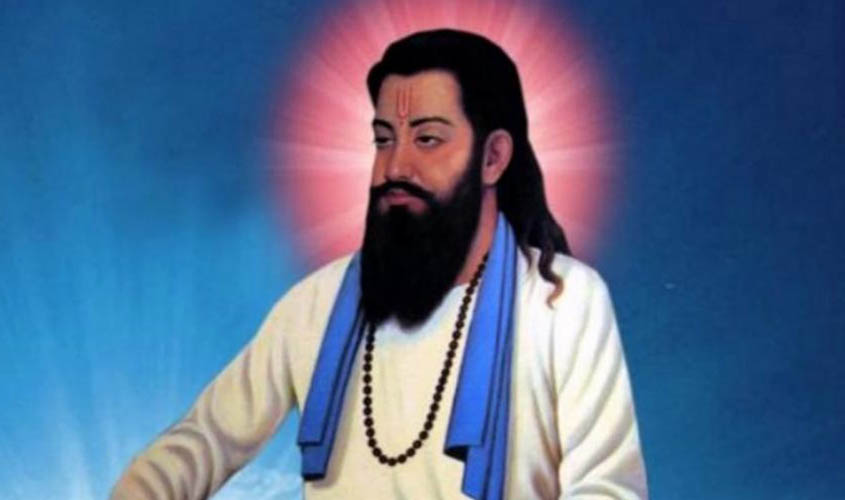Ravidas belonged to a circle of popular preachers coming from humble backgrounds of medieval Indian society.
From where is this low caste man getting the money?
This stupid villager does not even know how to spend it!
He is making a fool out of people—when has a Shudra ever done puja himself?
Brahmins of Banaras protesting against Sant Ravidas (quoted in Anantadas’ Parchai, circa 1600).
The Dalit followers of Sant Ravidas are agitated at present. Their temple at Tughlaqabad in south Delhi, a site reportedly occupied by them since the time of medieval Sultan Sikandar Lodi as per claims of a land grant, has been demolished following a recent court
Ravidasis are an assertive cluster of communities (identified as leather-workers, tanners, “untouchable” Chamars or Dalits), organised around devotional teachings of prominent medieval Bhakti Sant Ravidas. Himself a leather-worker, Ravidas belonged to a circle of popular preachers coming from humble backgrounds of medieval Indian society which included Sant Kabir (weaver) and Dadu Dayal (cotton-carder). They questioned and critiqued whimsical premises of powerful upper-caste groups which continuously sought to subjugate large sections of lower-caste people to a life of horrendous marginalisation.
Since archival documents are not generally available from the period before late 16th century, it will be difficult to historically prove the existence of a Ravidasi temple at a site reportedly granted by Sultan Sikandar Lodi. Traditions, memories and histories of such communities formed around ideas of Bhakti or devotion to a formless God (nirgun) go back several centuries. Several of them flourished in 15th and first half of 16th centuries, when Lodi and Sur Afghan rulers, with their seats of power in Delhi and Agra, created conditions conducive for formation and peaceful coexistence of communities—either with strict boundary-markers or as fluid syncretic sects. These social and political processes took more definitive forms under Mughal rulers subsequently.
Early histories of such communities spanning over three centuries (14th-16th) can only be written based on their social memories. Mention may be made here of Christian Lee Novetzki’s book on memory and history of people devoted to notions of Bhakti around Sant Namdev of Maharashtra, who, in turn, was a devotee of Lord Vitthal of Pandharpur. We do not have any credible written account about Namdev (probably belonging to the community of tailors) for nearly three centuries before samples of his devotional songs and some information on his life began to appear in late-16th century compositions relating to Bhakti Sants. This does not mean we can discard older memories relating to such Sants. Instead, memories of devout public attached to spiritual songs composed and sung by the Sants should be taken seriously for understanding their lives and communities of their followers.
Ravidas was a contemporary of Sant Kabir and other popular Sants, and they had reportedly interacted with each other. They had meetings with contemporary nobles and rulers as well. Folk traditions refer to political encounters beginning on a confrontational note but ending with mutual goodwill and respect. By Emperor Akbar’s time, in late 16th century, followers of such leaders needed both political support and writing of their popular vernacular histories, which justified and elaborated on their memories and traditions. Later generations have built upon them.
Sanity demands that Ravidasi historical traditions (since the late-16th century) and their oral traditions and memories going back another century or so are taken seriously. They have invoked memory and history going back to the lives and teachings of the Sants, challenging hierarchies based on birth and power and advocating equality and some sense of justice. Together, these egalitarian propositions also strove for some possibilities of social and political empowerment. Verses composed by the Sants in a variety of forms in several vernacular dialects are found in late-16th-century compilations—Guru Granth Saheb, Anantadas’ hagiographies (Parchai) and Nabhadas’ Bhaktamal. Even though boundary-markers of different communities and their identities have hardened since the latter half of the 19th century, they seek inspirations from older sources of their traditions.
Of particular significance is the multi-pronged strategy and struggle not only for survival but also to resist everyday social reality of caste-based humiliations, with the possibility of escaping into an almost utopian world, which was free from violent inequalities. Ravidas identified such a realm as Begampura, a habitation that was free from pain or sorrow (gam: derived from Persian gham). Within the Bhakti fold, Ravidas also transcended the nirgun/sagun divide. He asserted that one should not have dogmatic views about them:
“You should realise that nirgun and sagun are the same.
You must think of sagun as of butter
And nirgun as of heated ghee”.

